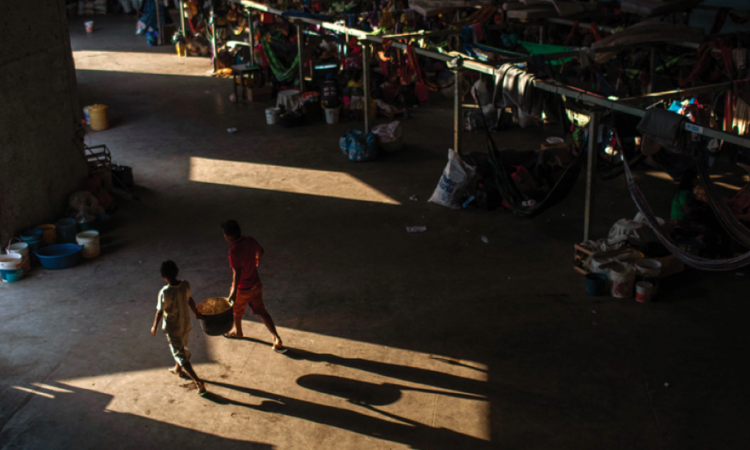The modern slavery estimates below are the result of a collaborative effort between the International Labour Organization (ILO) and the Walk Free Foundation, in partnership with the International Organization for Migration (IOM). They benefited from inputs provided by other UN agencies, in particular the Office of the High Commissioner for Human Rights (OHCHR).
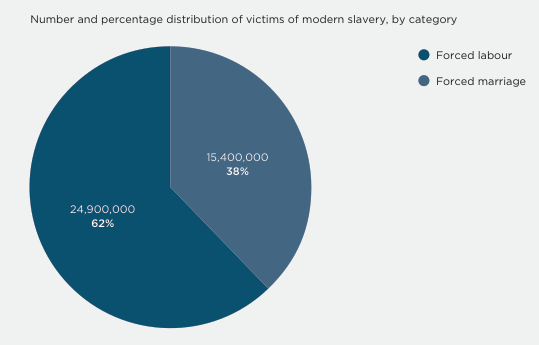
An estimated 40.3 million people were victims of modern slavery in 2016
In other words, on any given day in 2016, there were likely to be more than 40 million men, women, and children who were being forced to work against their will under threat, or who were living in a forced marriage that they had not agreed to. In terms of the prevalence of modern slavery, there were 5.4 victims for every thousand people in the world in 2016. Due to limitations of the methodology and data, these estimates are considered to be conservative.
Modern slavery: Number and prevalence of persons in modern slavery, by category, sex and age
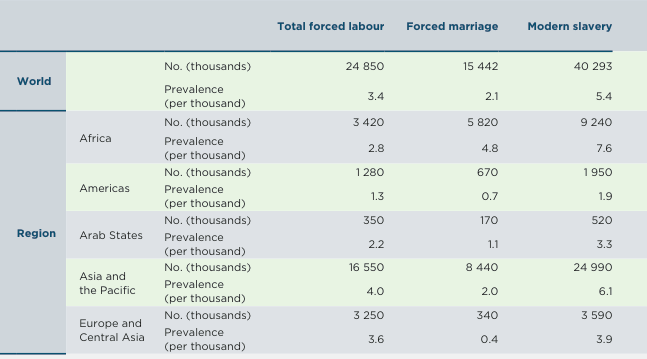
Of the total number of victims of modern slavery, 24.9 million people were in forced labour and 15.4 million people were living in a forced marriage
It is worth reflecting on what these figures mean:
▪ 24.9 million people were being forced to work under threat or coercion as domestic workers, on construction sites, in factories, on farms and fishing boats, in other sectors, and in the sex industry. They were forced to work by private individuals and groups or by state authorities. In many cases, the products they made and the services they provided ended up in seemingly legitimate commercial channels. Forced labourers produced some of the food we eat and the clothes we wear, and they have cleaned the buildings in which we live or work.
▪ 15.4 million people were living in a forced marriage to which they had not consented. That is, they were en- during a situation that involved having lost their sexual autonomy and often involved providing labour under the guise of “marriage”.
Women and girls are disproportionately affected by modern slavery, accounting for 71 per cent of total victims
The estimates suggest that far more females than males are affected by modern slavery (71 per cent versus 29 per cent). This varies across forms. Women and girls are disproportionately victimised above all for forced labour in the private economy (including domestic work and the sex industry) and forced marriage. Women and girls represented 99 per cent of victims of forced sexual exploitation and 84 per cent of victims of forced marriages.
This reflects highly gendered patterns of employment and migration and helps shed light on where prevention and victim identification efforts should be focused. But the data also suggests the relevance of broader patterns of human rights abuses that disproportionately affect women and girls, including domestic and sexual violence and discriminatory beliefs and practices around access to property, education, and even citizenship.
The Global Estimates indicate that men are disproportionately subject to state-imposed forms of forced labour, reflecting the impact on men of abusive conscription and imprisonment, and to forced labour in sectors that traditionally involve manual labour (construction, manufacturing, and agriculture/fishing). They also confirm that men and boys can be victims in all aspects of modern slavery, including forced sexual exploitation and forced marriage. Accordingly, it is critical that preventative efforts reflect this risk profile and also that national laws and responses to victimisation make allowance for male victims.
Modern slavery and sex of victim
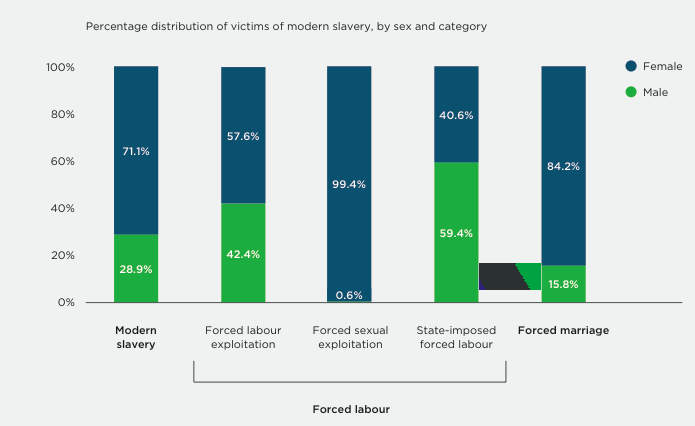
One in four victims of modern slavery in 2016 were children below the age of 18 years
One of the most alarming findings of the modern slavery estimates is the extent to which children are victims. One-quarter of all modern slavery victims – 10 million persons in all – were children. Children were especially likely to fall victim to forced marriage. Some 37 per cent, or 5.7 million, of those forced to marry were children. Children represent- ed 21 per cent of the victims of forced sexual exploitation, 18 per cent of those subjected to forced labour exploitation, and 7 per cent of people forced to work by state authorities.
There is in fact only a small difference between children and adults in terms of prevalence of modern slavery. There were 5.9 adult victims of modern slavery for every 1,000 adults in the world and 4.4 child victims for every 1,000 children in the world. When examining the rates of prevalence by form of modern slavery, adults were more likely than children to be victims of all three forms of forced labour; however, children were more likely than adults to be victims of forced marriage. For every 1,000 children, there were 2.5 victims of forced marriage, while for every 1,000 adults there were 1.9 victims of forced marriage.
Forced labour of children takes two pre- dominant forms. It can result from their guardians themselves being in forced labour, in which case the children work with their parents or at least for the same employer. Or the children may be in forced labour on their own as a result of trafficking, deceptive recruitment, or coercive means used by their direct employer. In the former case, parents are more likely to be aware of their children’s situation and working conditions. In the latter case, parents are less likely to be aware, as with children who migrate alone or are trafficked into forced labour, particularly domestic work.
Modern slavery and age of victim
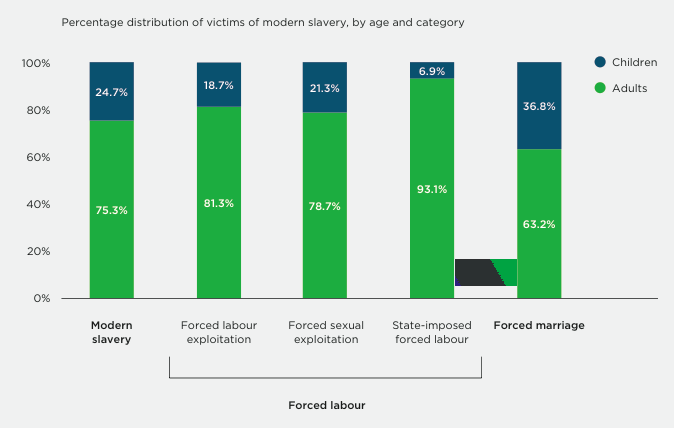
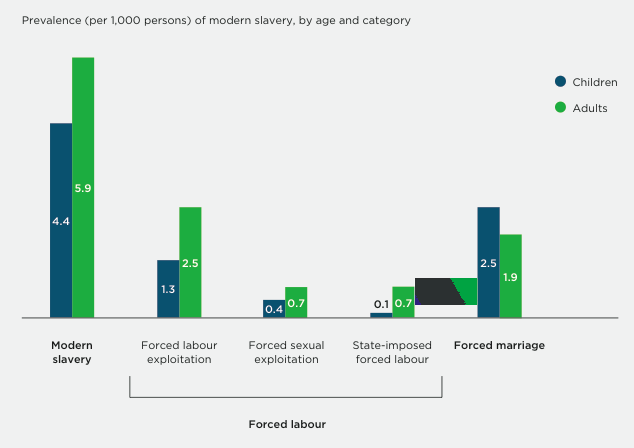
There was a total of 89 million victims of modern slavery over the period from 2012 to 2016; the time duration varied widely
Over the five-year period from 2012 to 2016, 89 million people were either in forced labour for a minimum number of days or entered into a forced marriage. Of these, 82.7 million were victims of forced labour and 6.5 million had been forced to marry against their will. There is wide variation in how long victims of modern slavery remain in their situation. While some manage to escape after a few days or weeks, others are trapped for years, as is the case for those in traditional forms of hereditary bonded labour and some forced marriages. For victims registered by IOM after 2012, the average duration in forced labour exploitation was slightly over 20 months and for the victims of sexual exploitation it was 23 months. Victims of forced labour imposed by state authorities were exploit- ed for a duration that varied from a few days per month (for example, when authorities force people to participate in illegal communal services) to several years for some cases of prison labour or forced labour in the context of military service.
The prevalence of modern slavery is highest in Africa
There were 7.6 victims for every thousand people in the Africa region. This was followed by the Asia and the Pacific region (6.1 per 1,000), Europe and Central Asia (3.9 per 1,000), the Arab States (3.3 per 1,000) and finally the Americas (1.9 per 1,000). Regional prevalence rankings differed for the two main categories of modern slavery – forced labour and forced marriage. Asia and the Pacific had the highest prevalence of forced labour (4.0 per 1,000) and Africa the highest prevalence of forced marriage (4.8 per 1,000). The regional figures are important but should be interpreted with care, bearing in mind critical gaps and limitations of the data.11 This is especially the case in Central Asia and the Arab States, where few surveys have been conduct- ed despite numerous reports of forced labour and forced marriages occurring.12 Far more research and survey work is required at the national level to provide a more comprehensive picture.
The populous Asia and Pacific region is host to by far the largest absolute number of victims of modern slavery
Figures for the absolute numbers of persons in modern slavery underscored the importance of the Asia and Pacific region, where 62 per cent of all victims of modern slavery worldwide were located. This was followed by the Africa region (23 per cent), Europe and Central Asia (9 per cent), the Americas (5 per- cent), and finally the Arab States (1 per cent). The Asia and the Pacific region has the highest share of victims across all forms of modern slavery, accounting for 73 per cent of victims of forced sexual exploitation, 68 per cent of those forced to work by state authorities, 64 per cent of those in forced labour exploitation, and 42 per cent of all those in forced marriages.
REGIONAL ESTIMATES
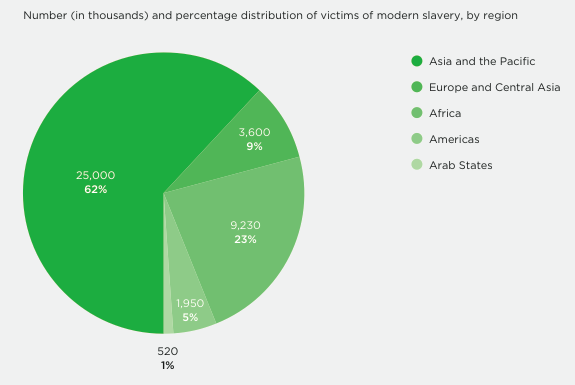
Modern slavery occurred in every region of the world. Modern slavery was most prevalent in Africa (7.6 per 1,000 people), followed by Asia and the Pacific (6.1 per 1,000) then Europe and Central Asia (3.9 per 1,000). These results should be interpreted cautiously due to lack of available data in some regions, notably the Arab States and the Americas.
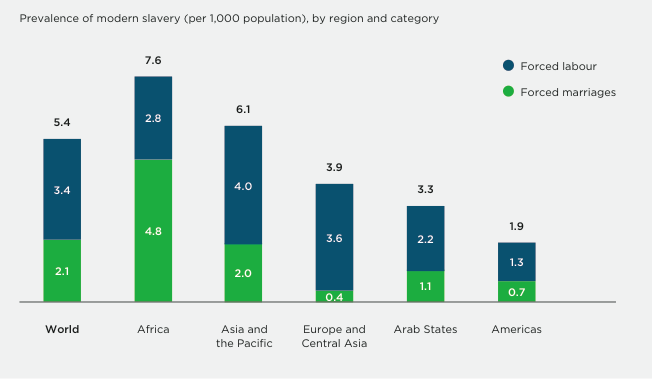
For forced labour specifically, the prevalence is highest in Asia and the Pacific, where four out of every 1,000 people were victims, followed by Europe and Central Asia (3.6 per 1,000), Africa (2.8 per 1,000), the Arab States (2.2 per 1,000) and the Americas (1.3 per 1,000).
While noting limits of the data in key regions, particularly the Arab States, the data suggests prevalence of forced marriage is highest in Africa (4.8 per 1,000), followed by Asia and the Pacific (2.0 per 1,000).
IMAGE CREDIT: IOM
